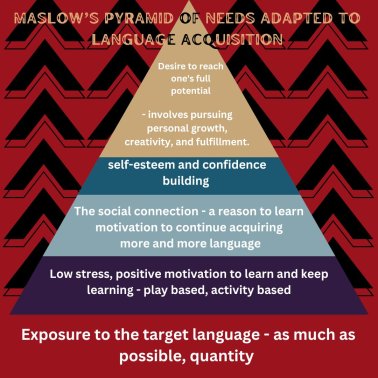Multi:Lingual
We still don't know exactly how the brain attains language, but we know it start very young. No matter the reasons you choose to raise a bi or multilingual child;
General Stages of Language Development
- Pre-linguistic stage
- Holophrastic or one-word stage
- Two-word stage
- Telegraphic stage
- Language explosion stage
- School-age stage
Influence on Language Learning
- Motivation: having a reason to learn the language
- Support at Home: help studying, motivating and support during frustrating times
- Prior Linguistic Knowledge: Learning one foreign language translates and aids in the learning of a second, third and so on
- Learning Environment: Positive, low stress, lots of chances to use the language, a lot of input.
- Teaching Strategies: Repetition and exposure have a huge effect on effective language acquisition but novelty and fun changes something from stagnation and boredom to learning without knowing it.
- Comprehensible Input: The language must be comprehensible but challenging to the child (Goldilocks rule)
- Child's Personality: introverts (output slower) vs Extroverts
- Age: Teens and up might have an accent. Older students might have trouble mimicking and or hearing foreign phonemes - like umlauts in German or tones in Chinese.
- Community: When moving to a foreign country, make sure to factor in transition times for both the language and emotions. Create places where the child feels welcome and learns things that are not language related. Movement, art, crafts, cooking, building, sculpting, weaving...
Building the Bi/Multi-Linguality of Children
Exposure
- Language of parents at home and language of the land at school and outside the home. Most common when parents are foreigners in the country they live in.
- Each parent speaks in their native language (note that if one parent speaks the language of the country you live in, that will more likely become the dominate language). This method often used when one or both parents are foreigners in the country they live in.
- Speak the target language at a certain time of day. This method might be used by caregivers who speak multiple languages. Although thought less effective, if you are teaching multiple languages at the same time there will be a dominate language (child feels most comfortable using) and other languages that take over when used. Speaking like a native in multiple languages takes time and effort - so don't be afraid to use any method that adds the other languages! Do what works for you
- Speak the target language on certain days of the week, like changing to target languages throughout the day, this method ensures that the target language is used, for larger chunks of time. This has the added benefit of not confining the vocabulary to certain actives - instead of only being used with the bed time rituals, it would include morning, daytime and night time activities.
Quality and Quantity
Although the time spent in a target language environment has a lot to do with acquisition, the difference between one hour of a target language a week and 3-4 hours a day is obviously going to make a big impact - but quantity is not enough. So talk to your children early and often. However, conversation is not measured by the amount of words spoken or heard - it is about the connection (emotional), reciprocity (relationship) and communication (listening and being heard). Build on these qualities and your child will build on their instinct to connect and communicate with you.
Benefits
The brain is extremely elastic and able - in the first few years of life, it acknowledges all phonemes as relevant and after a few months loses the ability to - holding on only to the phonemes in the language spoken to the child. Working on multiple language acquisition with your child does not guarantee language acquirement - but it is almost like it prepares the brain for the ability of an noun or verb to have multiple words attributed to it. This is not a foreign concept - think of 'child friendly' language for 'grownup' ideas. Or regional differences like pop and soda. Of course, this is a whole grammatical structure and the complexity of it creates for the speaker almost a parallel world to exist in. In knowing the two (or more) worlds, the child is no longer open to the concept of homogenization or simple forms of nationalism - they are beyond the one size fits all system. To this end, they are more accepting of diversity, question the need to conform and that there is only one way of thinking about things. Complexity is not to be feared. We are all complex, wether we live an examined or unexamined life. Multilingual children are portrait of that complexity.
Generalities of Culture
Every culture shapes its language to reflect its values and priorities. Just as tools are designed for specific tasks, words focus a speaker on what matters most in their daily lives. Take fishermen, for example. Their language might have a rich vocabulary for different fish species, crucial for identifying their catch. Similarly, language and culture are intertwined. While some claim Japanese lacks a direct "no," it's more accurate to say that expressing negativity directly can be considered impolite. This cultural emphasis on politeness shapes how the Japanese navigate conversations, requiring them to use alternative ways to decline requests. Each culture has different ways of using language, each one focuses on what is important to them.=

Place of Music
Every country, region and tribe has a musical culture, worthy of being listened to, worthy of participating in. Young children love to dance to the music of any and all kinds (though of course each person has an added personal flair for a particular beat). Don't hesitate to use music in your own target language, even translations of popular songs. "Baby Shark" might be an ear-worm that drives you batty, but for the time that it tickles your children's fancy, it can be used in multiple languages and even transition from one language to another.
Different types of videos offer different types of language exposure - Take the children's music album offered here
with no animation verses a song series with animation like this
More on Music Here
Repetition
- Music is a great way to add repetition to the language acquisition process without boredom or tedium. Adding a singsong tone to repetitive actions in your target language can help teach common phrases and vocabulary. Never underestimate the power of the singsong!
- Call and Respond while walking along is a great way to practice rhyming (considered a pre-reading-skill). Start with short two word calls and one or two word responses. Then ask child to call and you respond. If you get a good reception to this, when you learn a new word, add it to your repertoire!
- Activity books are fun ways to get that written repetition needed and often include other reading and writing skills that can be applied to other languages (following lines, following directions, cutting and gluing, sound to letter connections and so on).
- Journalling Young kids draw more than they write, but you could start a journal together with drawing and writing practice. This has the added bonus of cementing memories of the day, celebrating accomplishments and getting out worries. A great way to practice your target language and connect with your child.
- Routines Start utilizing routines to practice target language, especially morning and evening routines which the child already feels comfortable with.
- StoryTime Start adding a target language story time (so, read two books - one in your target language and one in your dominent language). Try to find books that have more concrete stories easily depicted in the pictures, and refer to those sections. For example if the story says "the dog's nose was black and wet," the picture is of a dog with a black nose; Ask the child what color the dog's nose is, not the meaning of the word wet. They can learn that another time. Don't translate line for line! The child will listen to the part they can understand and ignore the rest. Instead translate some lines each time you read the same book. Books with repeating parts are learned quickly. If you are having a hard time finding books in your target language, try Dora the Explore. Look for the ones that are not level 1 readers. They are over simplified and don't have as many Spanish words in them. If you target language is not Spanish, change the Spanish to the target language. Young children like calling out the words Dora needs.
- Family Call If you can, call family that speaks the target language on a weekly basis. This and visiting motivates young learners to keep practicing even when it is hard. Often times time differences can be a challenge, but it is worth it, if the child gets to hear and try to speak a little, as well as having the added bonus of connection.
- Video from Home (adapted from ColorinColorado Because of time differences, it is not always possible to have a weekly call to your home country. Consider setting up a weekly video update to send. The other side might want to send a video back, which would create a sense of continuation, but of course no expectation for what others can or will do. The benefits are more than just practicing a key phrase, but the child can also tell about what they have been doing, what they enjoyed, creating a sense of self reflection.
Place of Humor
For younger children, silliness is a great asset. For older children, reading humorous text in the target language, even funny child-friendly videos in the target language (no subtitles) can make learning more fun. Try creating an alter ego for you for when you use your target language with the child. Then using the alter ego, start a short five minute movement and dance session for your before school routine and before night time routine. Use this to get your energy going in the morning - so more exercise and dance oriented - the sillier the better; Get your energy out for night time readiness with stretches and yoga. Speak in the target language and let child follow your body movements as best they can.
Suggestion for morning: Cross Crawl (from Smart Moves by Dr. Hannaford) Touch your right elbow to your left knee and then the left elbow to the right knee. Preform the cross crawl very slowly.
Suggestion for night: Elephant (from Smart Moves by Dr. Hannaford)
- Place left ear on left shoulder, tight enough to hold a piece of paper in place.
- Extend left arm like a trunk
- With knees relaxed, the arm draws 'infinite' symbol in the air (eyes should follow movement)
- Do this slowly, 3-5 times - each side
Resources
Play these games in your target language

























